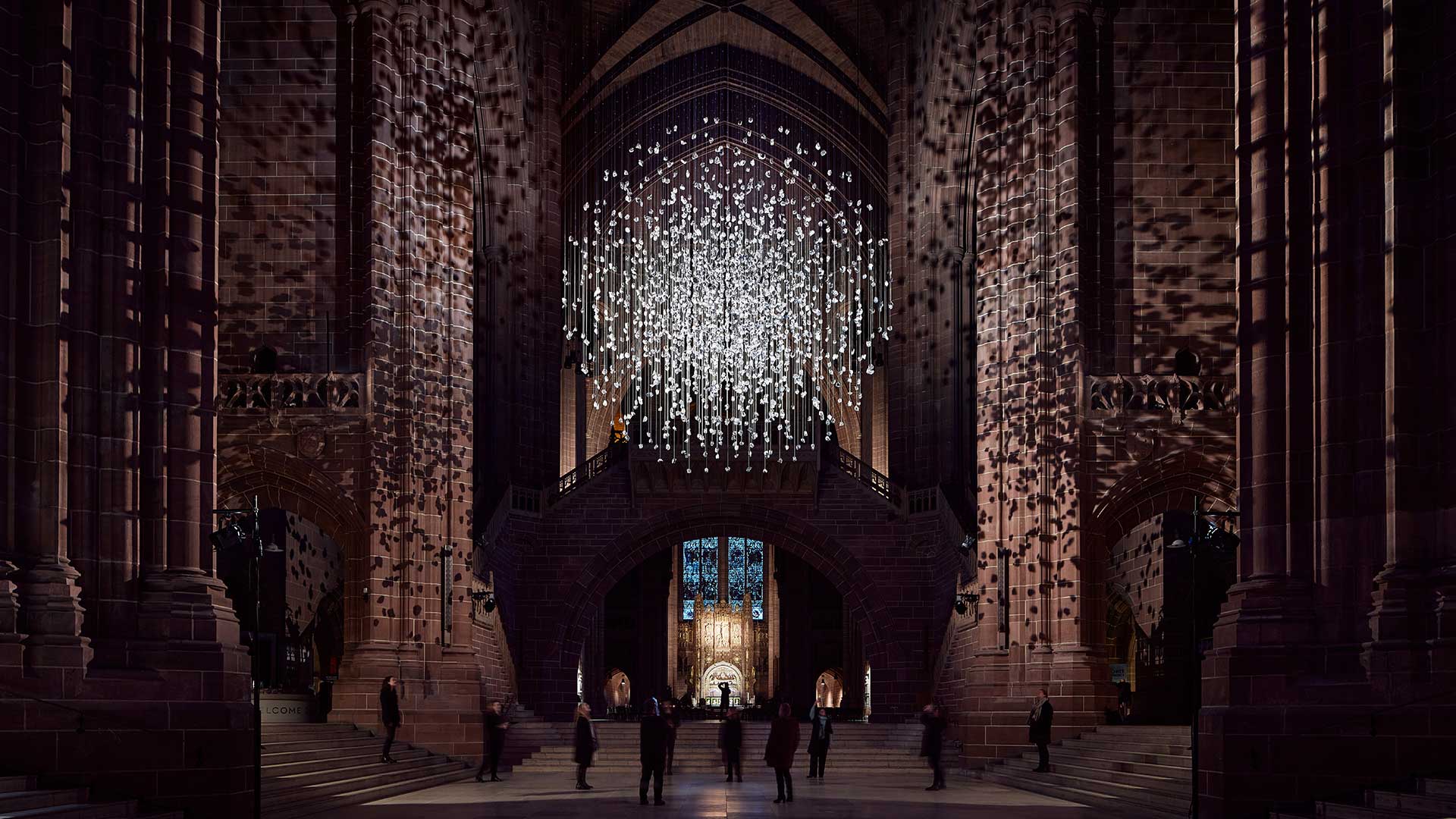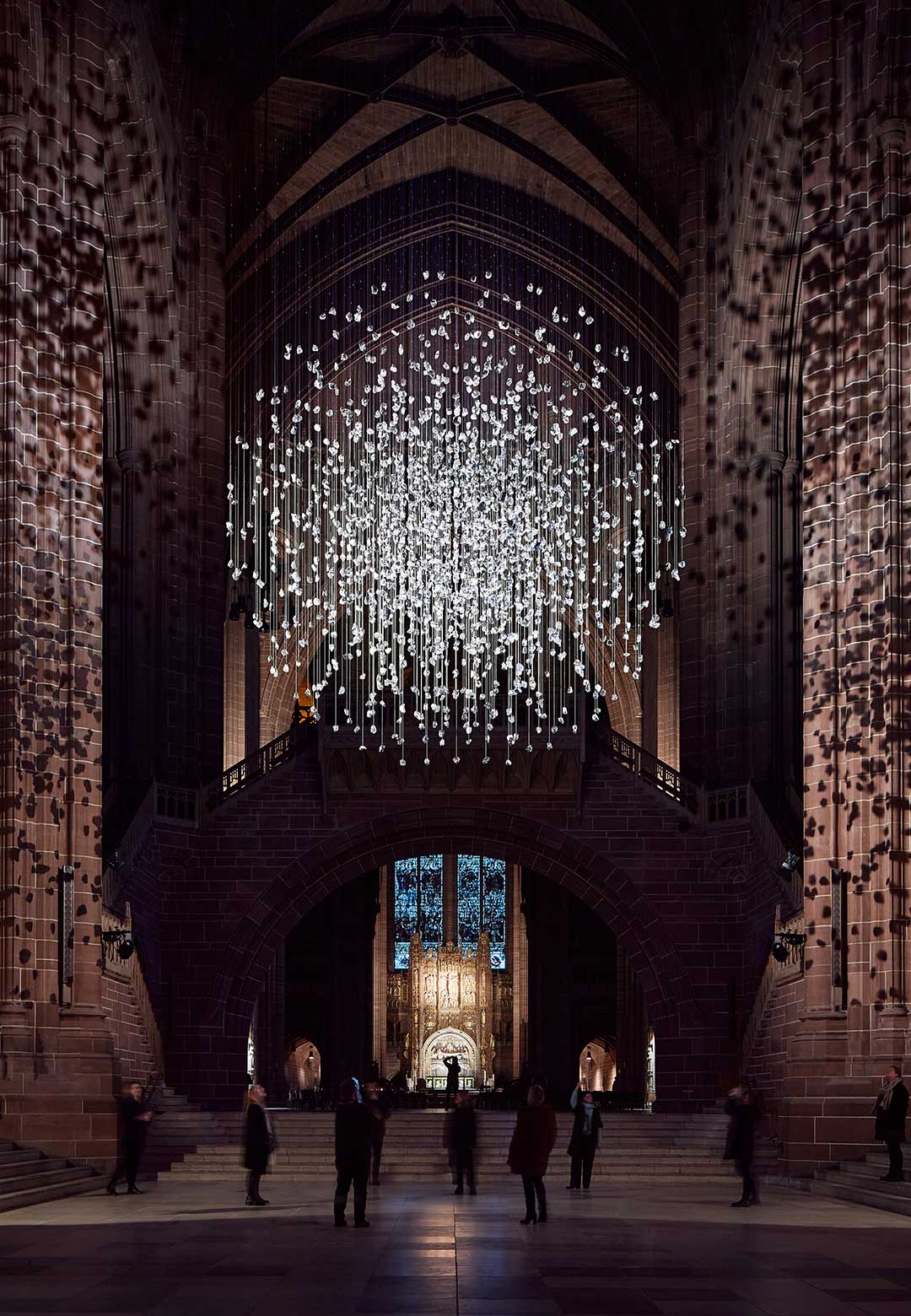Should art and design industries encourage more active participation, or even stimulate perspective towards environmental change, in an accessible and united manner?
Across the last few generations, we have come to comprehend how enormously damaging the burning of fossil fuels has been to the planet’s health, not to mention how equally disastrous the repercussions are to human life as well as the environment, to extract them. Conversely, humankind and technology would not have advanced to the rate we are accustomed to currently, had it not been for the burning of fossil fuels (re: the Industrial Revolution). But at this point in the 21st century, we know better to adapt, to find solutions instead of supporting plain environmental exploitation. So how does one bring the general public’s attention to this predicament? Maybe, one of the routes could be through largely accessible formats of media and creative arts.
British designer Paul Cocksedge has conceived ‘Coalescence’, a sculptural art installation that questions the way humankind consumes energy, and our dependence on burning fossil fuels. An obvious sparkling beauty, a beauty that is thought-provoking and accessible, the monumental sculptural installation goes beyond its aesthetics with its message, by literally fashioning itself out of the material in question—fossil fuels—made from over 2,000 pieces of anthracite coal, ‘Coalescence’ debuted on February 09, 2023, and is currently illuminated and suspended from the ceiling of the Liverpool Cathedral in the UK, where it shall remain free to view until March 12, 2023. Made in partnership with Carpenters Workshop Gallery, the free installation forms part of a programme of events, exhibitions and artworks leading up to Liverpool Cathedral’s 100th anniversary next year.
Wanting it to look like ‘an expansion of energy’, the spherical large-scale art installation spans six meters in diameter and hangs resplendent like a glimmering, crystal chandelier against the grand backdrop of the Gothic cathedral. Suspended using 16 km of wire, each ending in over 2,500 pieces of treated coal, the public artwork is illuminated to emphasise the anthracite’s distinctive, lustrous surface, casting alluring, freckled shadows on the cathedral’s walls.
The genesis of the installation was based on the statistic that a 200W light bulb turned on for a year would consume over half a tonne of coal. ‘Coalescence’ visualised this precise amount through hand-drilled and suspended pieces of anthracite, a high-carbon form of coal that’s extremely low in impurities and is often used for filtration, excavated in the UK. The act of lifting the piece and illuminating is also quite symbolic, referencing the extraction of coal from the ground for our use.
“This piece feels apt, considering the current conversations around energy consumption. As a maker, it was important for me to go to the source and be part of the excavation process. I spent months hand-drilling each piece of coal, which gave me a new appreciation for the beauty of working with natural materials. It’s easy to forget the origins of the energy that’s required in almost every aspect of our lives,” shares Cocksedge.
The Liverpool Cathedral remained one of the most visited cathedrals in the UK, welcoming over 800,000 visitors each year, before the coronavirus pandemic. “As a place of encounter, contemplation and reflection, Liverpool Cathedral is a space where people can come to find a sense of joy and wonder as they connect with thought-provoking artworks like ‘Coalescence’,” says The Dean of Liverpool, The Very Revd Dr Sue Jones. “Our previous collaborations with contemporary artists have been extremely well received and we’re very much looking forward to encouraging people to take time out to appreciate the remarkable beauty of ‘Coalescence’ as they consider some of the issues explored by the piece,” he adds.
“As a place of contemplation, Liverpool Cathedral felt like the perfect space to show ‘Coalescence’. I hope it encourages conversation and debates around our relationship with fossil fuels and the need to reach net zero,” the British designer adds.
In conversation with STIR, the founder of Paul Cocksedge Studio touches upon the intent of ‘Coalescence’, urging its viewers to really think about where energy comes from, how we produce it for the lives we are accustomed to, and how we need to start moving away from using fossil fuels, and towards more sustainable alternatives of energy consumption.
Jincy Iype: What formed the impetus for Coalescence?
Paul Cocksedge: The realisation that one lightbulb turned on for an entire year requires over half a tonne of coal— The very fact that it takes all this coal to power one lightbulb is astonishing, and a little bit uneasy. When you think about the amount of material being removed from the ground, that’s taken millions of years to form, it gets you wondering.
On the one hand, it’s clear that without coal the world we live in would be completely different and in many ways less advanced. But on the other, we know that burning coal has had a huge negative impact on the planet. It’s now time to have the confidence to embrace alternatives.
Personally speaking, this piece was a wake-up call. Seeing this material being literally extracted from the earth was an eye-opening experience. Raising it in the public space of Liverpool Cathedral, particularly at a time when all of us are talking about energy consumption, felt apt.
Jincy: Why coal? How did you zero in on this specific type of material for the piece, and what can you tell us about its sourcing and treatment?
Paul: It was sourced from one of the last coal mines in the UK. For a long time, I’ve been curious about working with coal, and we’re living in a time where people are debating about the costs of energy, and ideally, moving away from using fossil fuels. It felt right to somehow capture all these conversations through the design.
We extracted the material from the quarry, shaped the coal to make smaller pieces out of bigger boulders, weighed them to reach a precise value, drilled a hole in each one, and threaded and suspended them.
Jincy: What informed the name of the installation, apart from its primary materiality of coal?
Paul: When I heard the meaning of that name I thought it was perfect, because it has all these thousands of pieces of anthracite (a form of coal) coming together to create the entire sculpture. But they also come together to communicate this idea about a single light bulb and energy.
Jincy: Why was the Liverpool Cathedral chosen for the installation’s debut, and how does this location influence the design?
Paul: We wanted a place that was public, free, and open, and this cathedral with its open doors, allowing people to come and reflect, was a perfect match for the art installation.
Jincy: How would you describe the essence of the art installation, especially in terms of it being accessible to all?
Paul: There’s a simple starting point which is about a single light bulb, but when you encounter the installation you’re taken aback by its surprising materiality – which shows coal going through a complete transformation from something dark and dusty to something gleaming and almost crystalline. It becomes something that is very hypnotic and, in a way, quite spiritual – you look at it and you’re taken away to other places.
Jincy: Could you elaborate on something you said—"Personally speaking, this piece was a wakeup call. Seeing this material being literally extracted from the earth was an eye-opening experience."
Paul: I’ve seen first-hand how much energy is required to extract coal from the ground, and if you imagine all the billions of light sources around the world, you realise and quantify the amount of matter needed to produce energy. Once you begin to visualise that, it becomes quite unnerving, because you wonder where all this material is. It suddenly sharpens your focus to the problem, but also creates that optimistic feeling that we have alternatives like solar, wind or tidal.
Jincy: How was it working primarily with your hands for an installation of this scale?
Paul: That was one of its delightful points. We learned so much through the act of making, which has continued to inform new work. Being involved in the sourcing of the material as well as its manufacturing has remained an important part of what the studio does. Being able to experience that materiality personally was quite transformative and crucial to the artwork’s development.
Jincy: Could you take us behind the technicalities of illuminating the sculpture?
Paul: We illuminated it from several directions with a spotlight, and this achieved its dazzling reflections.
Jincy: What are your favourite parts of the installation?
Paul: My dad said it looked like the Big Bang, which felt fitting as it’s in a place of worship where daily discussions about life occur.
Jincy: What will happen to the sculpture post-March 12, 2023?
Paul: We’ve had such good feedback and we would like to tour it. People are already asking us about bringing it to different locations.
Perhaps it is the purpose of art to be contradictory in its performance, to be accessible and relevant—in this case, I refer to the primary materiality of Coalescence that extracts and employs the very element that it is bringing awareness to. Although not all types of coal are burned for fuel—the kind used for this installation, because of its high carbon content, is mainly used for water filtration. In a nutshell, it does achieve its purpose, of prompting bigger questions around energy consumption while being incredibly alluring and could purely be seen as a creative means to the end, demanding the attention of all those who encounter it.






 Sign in with email
Sign in with email








What do you think?